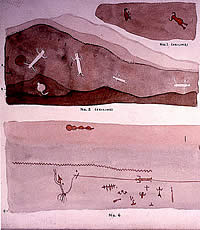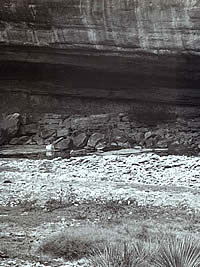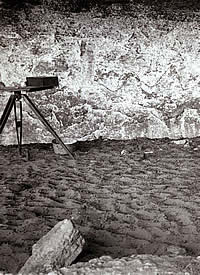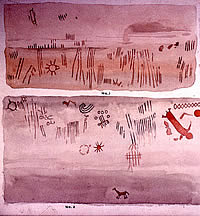Lehmann Shelter
Lehmann Shelter in northeast Gillespie County is a remarkable ancient place because it is one of the easternmost sites in the region with extensive pictographs (painted designs). Pictographs are increasingly rare as one moves from the dry west to the wet east in Texas – and are known from only a few localities in the central and eastern Edwards Plateau.
The Gillespie County pictographs probably date to the Late Prehistoric or early Historic periods, much later in time than the 4,000 year old pictographs in the Lower Pecos. Lehmann Shelter serves as a reminder that the prehistoric peoples living all across the Edwards Plateau probably adorned the limestone overhangs and cliff faces in their territories with created vivid symbolic art, only traces of which have survived the ravages of time.
Lehmann Shelter (41GL1) was briefly investigated in 1936 by a field team led by A.M. Woolsey of the University of Texas. This natural shelter is located in a limestone bluff along Onion Creek. Excavations there recovered artifacts left by Archaic and Late Prehistoric cultures including projectile points, knives, scrapers, flint and bone awls, and two potsherds. A human burial believed to date to Toyah times was also discovered during excavation but was not recovered intact. In addition, bedrock mortar holes used to pulverize nuts or seeds were present in flat-topped limestone boulders at the front of the shelter. Woolsey called these “table rocks.”
Painted designs, or pictographs, cover 138 linear feet of the shelter’s rear wall and ceiling. Prehistoric paintings such as these are not commonly found in the central Edwards Plateau. These were not as well preserved as those at many of the pictograph sites in the Lower Pecos Canyonlands. The Lehmann Shelter pictographs contain images of humans, animals, such as deer and birds, and geometric designs such as parallel, wavy and zigzag lines, circles, and dots. Most of the pictographs are in red, with a few in black and white. Pioneering rock art illustrator Forrest Kirkland visited the site in July 1936 and drew watercolor copies of the pictographs, several of which are shown here.
In addition to its pictographs, Lehmann Rock Shelter is unique in that it is one of the sites that yielded evidence used by archeologist J. Charles Kelley in his 1947 attempt to construct a cultural history sequence for the entire prehistory of Texas. Kelley’s proposed classification scheme did not win acceptance, but he correctly saw the need to work out the long sequence of successive prehistoric cultures in the region. It took several more decades and many more digs before archeologists developed a more-detailed chronological scheme that is widely accepted (see Prehistory section by closing this window and clicking the Prehistory icon).
References:
Kelley, J. Charles
1947 The Lehmann Rock Shelter: A Stratified Site of the Toyah, Uvalde, and Round Rock Foci. Bulletin of the Texas Archeological and Paleontological Society 18:115-128.
Kirkland, Forrest and William W. Newcomb
1967 Rock Art of Texas Indians. University of Texas Press, Austin. (Reprinted in 1996.)



